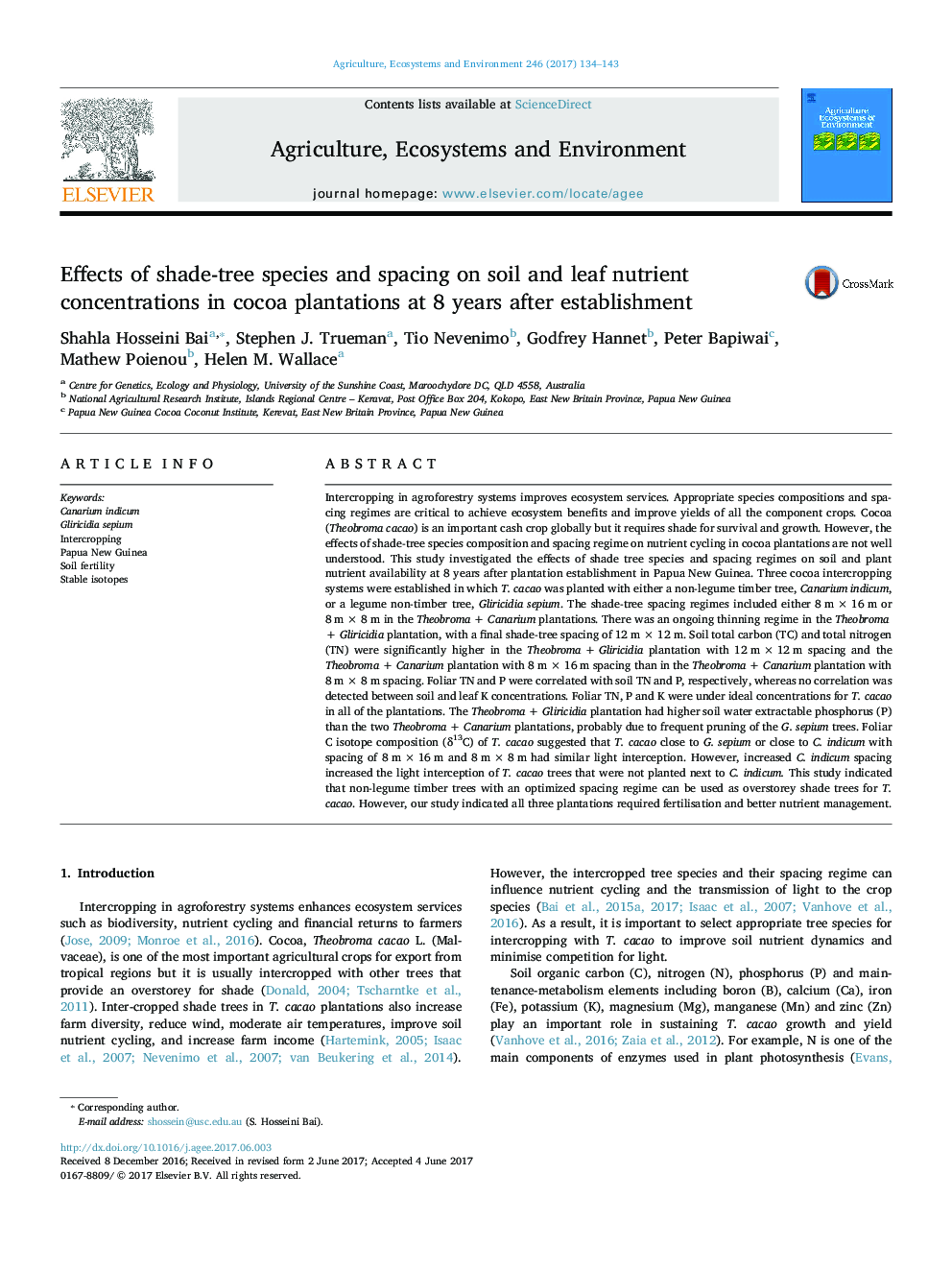| کد مقاله | کد نشریه | سال انتشار | مقاله انگلیسی | نسخه تمام متن |
|---|---|---|---|---|
| 5538037 | 1552006 | 2017 | 10 صفحه PDF | دانلود رایگان |
عنوان انگلیسی مقاله ISI
Effects of shade-tree species and spacing on soil and leaf nutrient concentrations in cocoa plantations at 8 years after establishment
ترجمه فارسی عنوان
تأثیر گونه های درخت سایه و فاصله آن بر غلظت مواد مغذی خاک و برگ در گیاهان کاکتوس طی 8 سال پس از استقرار
دانلود مقاله + سفارش ترجمه
دانلود مقاله ISI انگلیسی
رایگان برای ایرانیان
کلمات کلیدی
موضوعات مرتبط
علوم زیستی و بیوفناوری
علوم کشاورزی و بیولوژیک
علوم زراعت و اصلاح نباتات
چکیده انگلیسی
Intercropping in agroforestry systems improves ecosystem services. Appropriate species compositions and spacing regimes are critical to achieve ecosystem benefits and improve yields of all the component crops. Cocoa (Theobroma cacao) is an important cash crop globally but it requires shade for survival and growth. However, the effects of shade-tree species composition and spacing regime on nutrient cycling in cocoa plantations are not well understood. This study investigated the effects of shade tree species and spacing regimes on soil and plant nutrient availability at 8 years after plantation establishment in Papua New Guinea. Three cocoa intercropping systems were established in which T. cacao was planted with either a non-legume timber tree, Canarium indicum, or a legume non-timber tree, Gliricidia sepium. The shade-tree spacing regimes included either 8 m Ã 16 m or 8 m Ã 8 m in the Theobroma + Canarium plantations. There was an ongoing thinning regime in the Theobroma + Gliricidia plantation, with a final shade-tree spacing of 12 m Ã 12 m. Soil total carbon (TC) and total nitrogen (TN) were significantly higher in the Theobroma + Gliricidia plantation with 12 m Ã 12 m spacing and the Theobroma + Canarium plantation with 8 m Ã 16 m spacing than in the Theobroma + Canarium plantation with 8 m Ã 8 m spacing. Foliar TN and P were correlated with soil TN and P, respectively, whereas no correlation was detected between soil and leaf K concentrations. Foliar TN, P and K were under ideal concentrations for T. cacao in all of the plantations. The Theobroma + Gliricidia plantation had higher soil water extractable phosphorus (P) than the two Theobroma + Canarium plantations, probably due to frequent pruning of the G. sepium trees. Foliar C isotope composition (δ13C) of T. cacao suggested that T. cacao close to G. sepium or close to C. indicum with spacing of 8 m Ã 16 m and 8 m Ã 8 m had similar light interception. However, increased C. indicum spacing increased the light interception of T. cacao trees that were not planted next to C. indicum. This study indicated that non-legume timber trees with an optimized spacing regime can be used as overstorey shade trees for T. cacao. However, our study indicated all three plantations required fertilisation and better nutrient management.
ناشر
Database: Elsevier - ScienceDirect (ساینس دایرکت)
Journal: Agriculture, Ecosystems & Environment - Volume 246, 1 August 2017, Pages 134-143
Journal: Agriculture, Ecosystems & Environment - Volume 246, 1 August 2017, Pages 134-143
نویسندگان
Shahla Hosseini Bai, Stephen J. Trueman, Tio Nevenimo, Godfrey Hannet, Peter Bapiwai, Mathew Poienou, Helen M. Wallace,
